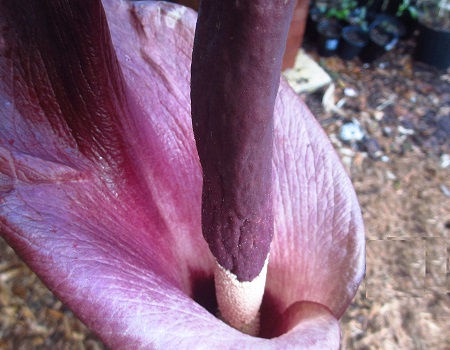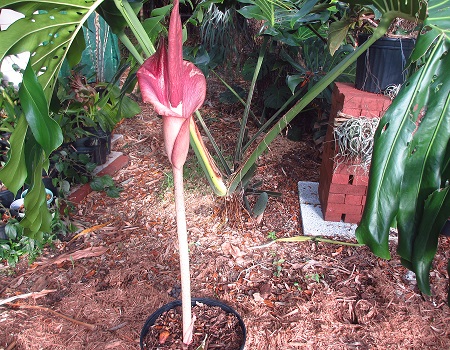Amorphophallus konjac is grown extensively throughout Asia as a food crop.
Amorphophallus konjac (syn. A. rivieri),has an edible corm (bulbo-tuber). Shiritaki noodles are made from the tubers of Amorphophallus konjac. It is also known as konjaku, konnyaku potato, devil’s tongue, voodoo lily, and snake palm.
Origin
China
Family
Araceae
Binomial nomenclature
Amorphophallus konjac
Common names
Voodoo lily
Description
It is a perennial plant, growing from a large corm up to 25 cm (10 in) in diameter. The single leaf is up to 1.3 m (4 ft) across, bipinnate, and divided into numerous leaflets. The flowers are produced on a spathe enclosed by a dark purple spadix up to 55 cm (22 in) long.
Height
4-5′ tall.
Temperature/Zone
zone 9b, 32°F. This plant prefers humid conditions. It goes dormant in Winter. The tubers can be dug up and Wintered in a paper bag, anywhere in the USA.
Light
Part sun to shade.
Water
Keep them evenly hydrated while they are growing, but allow them to dry out completely while they are dormant. If they are too wet while they are dormant they can rot.
Fertilizer
It is important to supply them with phosphorus. Phosphorus is what allows them to grow a larger tuber. Since they grow a new tuber each year, this is largely what determines the size of the plant in the following year. Just as I do for gingers, I use a 1/4 strength liquid fertilizer, formulated for tomatoes on these.
Cultivation
Plant the tuber in very rich, well draining soil. Give them a good amount of root space. Plant it in the pot it will be in for the whole season. You should not transplant them while they are growing. I’ve done it, but it is best not to disturb their roots once they are growing. If the leaf petiole is broken or badly damaged during transplantation it will often cause them to die. It is for this reason that I don’t ship them while they are growing.
Pests
I have not found any pests to be a problem for this plant in Florida.


